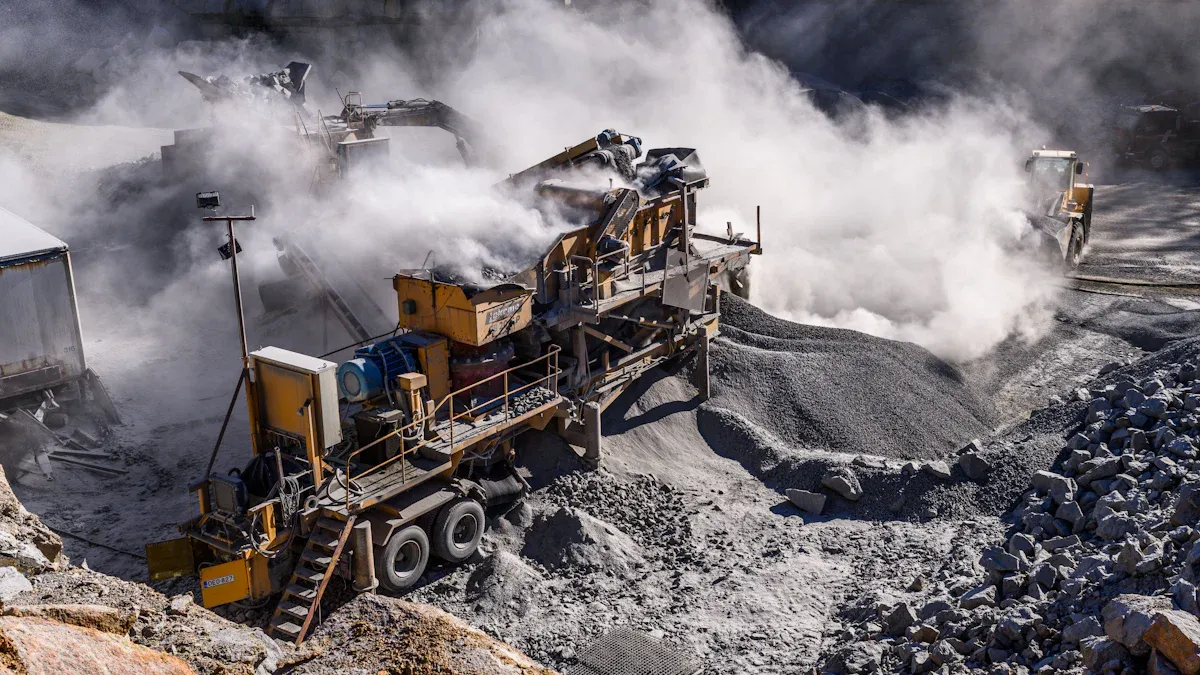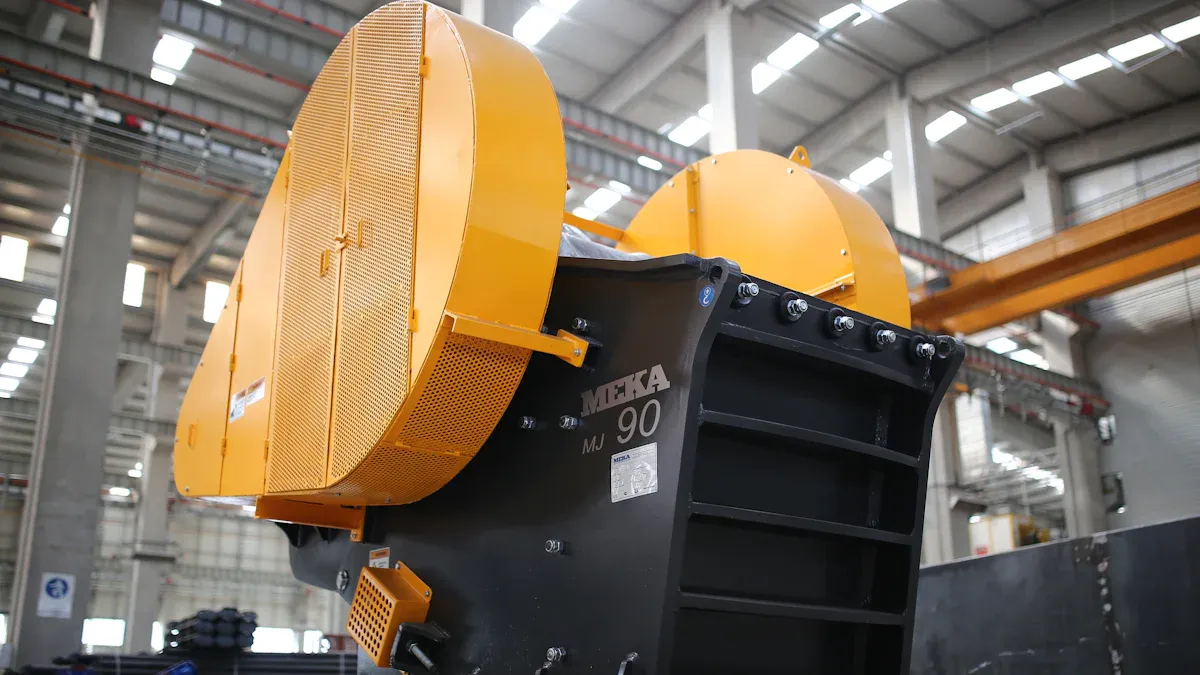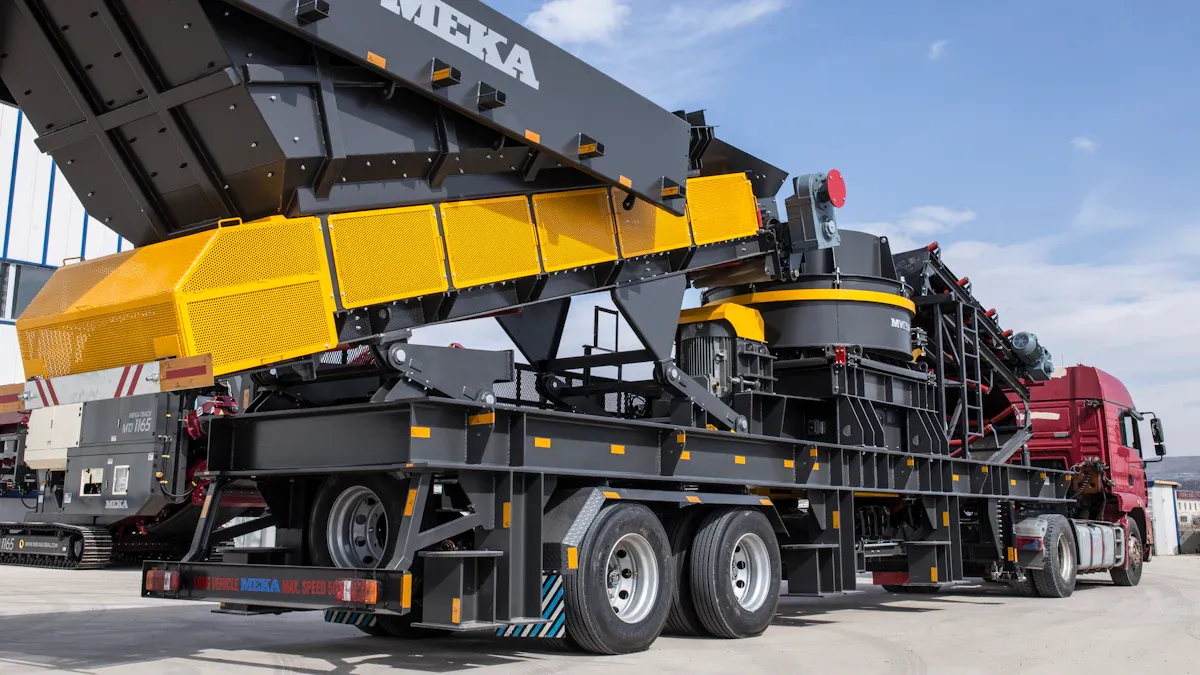
Understanding the wear parts of your jaw crusher is essential for keeping it running efficiently. These components handle immense pressure and friction daily, making them prone to wear and tear. For instance, integrating wear-resistant materials can significantly extend their lifespan, minimizing downtime and cutting operating costs. Advanced control systems now allow you to monitor these parts closely, optimizing maintenance schedules. With the rising demand for aggregates in construction, ensuring your crusher operates seamlessly becomes even more critical. By identifying critical wear parts, you reduce disruptions and improve overall machine performance.

Jaw plates are the primary wear parts of a jaw crusher. They play a critical role in crushing materials by applying immense pressure to break down rocks and other aggregates. These plates are mounted on the fixed and moving jaws of the crusher, ensuring efficient material reduction. Without properly functioning jaw plates, the crushing process becomes inefficient, leading to reduced productivity.
📌 Did you know? Advanced modeling techniques have shown that optimizing jaw plate design can reduce weight by 10-25%, improving overall performance. Additionally, the stiffness of the swing plate significantly impacts the crusher's effectiveness.
The importance of jaw plates extends beyond crushing. They also influence the machine's energy consumption and operational costs. A well-designed jaw plate ensures uniform wear, reducing the need for frequent replacements and minimizing downtime.
The durability of jaw plates depends on the materials used in their construction. High-quality materials like martensitic steel and EN31 steel are commonly used due to their strength and resistance to wear. Research indicates that EN31 steel offers superior durability, making it ideal for prolonged industrial use.
However, even the best materials face challenges. Prolonged use can lead to plastic deformation, deep scratches, and pits. Chisel cutting wear is a common issue, often exacerbated by contact fatigue and oxidation corrosion. Selecting the right material for your jaw plates can significantly extend their lifespan and improve the overall efficiency of your jaw crusher.
Knowing when to replace jaw plates is crucial for maintaining your crusher's performance. Here are some key indicators:
- Inspect jaw dies daily to ensure bolts remain tight.
- Avoid using jaw plates that have become too thin, as this can lead to loss of wear and reduced crushing efficiency.
- Replace worn jaw plates promptly to maximize their lifespan and prevent damage to other components.
Regular inspections and timely replacements not only enhance the crusher's performance but also reduce long-term maintenance costs. By staying proactive, you can ensure your jaw crusher operates at peak efficiency.
Cheek plates are essential components in the operation of a jaw crusher. They are mounted on the sides of the crushing chamber and serve as protective liners. Their primary role is to shield the crusher's main frame from wear caused by the constant friction and impact of crushed materials. Without cheek plates, the machine's structural integrity would weaken over time, leading to costly repairs or even equipment failure.
You can think of cheek plates as the unsung heroes of the crushing process. While they don't directly crush materials, they ensure the jaw crusher operates smoothly by preventing damage to critical parts. This protection helps maintain consistent performance and extends the machine's lifespan.
💡 Tip: Regularly inspect the cheek plates for signs of wear. Early detection can save you from unexpected downtime and expensive repairs.
The durability of cheek plates depends heavily on the materials used in their construction. Manufacturers typically use high-manganese steel or alloy steel for these components. High-manganese steel is popular because it hardens under pressure, making it highly resistant to abrasion. Alloy steel, on the other hand, offers a balance of strength and toughness, making it suitable for heavy-duty applications.
When selecting cheek plates, you should consider the type of material being processed. For instance, harder materials like granite may require cheek plates with higher wear resistance. Softer materials, such as limestone, may not demand the same level of durability. Choosing the right material ensures optimal performance and reduces the frequency of replacements.
Proper maintenance of cheek plates is crucial for the efficient operation of your jaw crusher. Here are some practical tips to keep them in good condition:
1. Inspect regularly: Check the cheek plates for cracks, dents, or excessive wear.
2. Tighten bolts: Loose bolts can cause the plates to shift, leading to uneven wear.
3. Replace when necessary: Worn-out cheek plates can compromise the crusher's performance. Replace them promptly to avoid further damage.
4. Clean the plates: Remove any debris or buildup that could accelerate wear.
By following these maintenance practices, you can extend the life of your cheek plates and ensure your jaw crusher operates at peak efficiency.

Toggle plates play a vital role in the operation of a jaw crusher. They transfer mechanical force from the motor to the moving jaw, enabling the crushing process. Acting as a connecting link, they ensure the smooth movement of the jaw and maintain the machine's efficiency. Without a properly functioning toggle plate, the crusher cannot perform its primary task of breaking down materials effectively.
These plates also act as a safety mechanism. When uncrushable materials, such as metal or oversized rocks, enter the crusher, the toggle plate absorbs the impact. This prevents damage to critical components like the jaw and frame. By breaking under extreme pressure, the toggle plate protects the machine from costly repairs and downtime.
Toggle plates are designed with built-in protective features to safeguard the jaw crusher. For instance, they act as a fail-safe device. If the crusher encounters uncrushable materials, the toggle plate breaks first. This allows the uncrushable material to fall out, preventing damage to more expensive parts.
A notable example is the case of Kirkbride v. Terex USA, where it was highlighted that toggle plates serve as protective devices. Their ability to break under stress ensures the longevity and reliability of the equipment. This feature makes them indispensable for maintaining the crusher's structural integrity and operational efficiency.
Replacing toggle plates at the right time is crucial for the jaw crusher's performance. Here are some best practices to follow:
1. Inspect regularly: Check for cracks, bends, or excessive wear.
2. Use compatible parts: Always replace toggle plates with manufacturer-approved components to ensure proper fit and function.
3. Monitor performance: If the crusher's efficiency drops or unusual noises occur, inspect the toggle plate immediately.
4. Follow installation guidelines: Improper installation can lead to premature failure. Refer to the manufacturer's manual for correct procedures.
By adhering to these practices, you can extend the life of your toggle plates and maintain the crusher's efficiency. Regular maintenance not only reduces downtime but also minimizes long-term repair costs.
Bearings are critical to the smooth operation of your jaw crusher. They support the rotational movement of the machine's components, ensuring efficient crushing. The type of bearing you choose directly impacts the crusher's performance and lifespan. For heavy-duty applications, spherical roller bearings are ideal. They handle misalignment and shock loads effectively. Tapered roller bearings, on the other hand, manage both radial and axial loads, making them versatile for varying operational demands.
The working environment and material characteristics also influence bearing performance. Dust, high temperatures, and heavy loads can shorten their lifespan. Proper maintenance, including grease application, is essential to keep them functioning optimally. By selecting the right bearings and maintaining them well, you can enhance the efficiency and durability of your jaw crusher.
Bearings often face challenges like inadequate lubrication, contamination, and misalignment. These issues can lead to overheating, vibration, and even premature failure. To prevent such problems, you should:
- Use proper mounting techniques to avoid misalignment.
- Follow manufacturer guidelines for lubrication to prevent friction and wear.
- Inspect bearings regularly to detect contamination or damage early.
- Monitor operational loads to avoid overloading or skidding.
Environmental factors, such as dust and moisture, can also harm bearings. Sealing techniques help protect them from these elements. Less than 1% of rolling bearings fail prematurely when maintained correctly. By addressing these common issues, you can reduce downtime and extend the life of your equipment.
Lubrication plays a vital role in bearing maintenance. Proper grease selection reduces energy consumption and heat production, ensuring smooth operation. For example, grease with good channeling characteristics minimizes friction and prolongs bearing life. Monitoring lubrication conditions is equally important. Cleaner oils can improve efficiency and reduce fuel consumption by up to 4%.
You should also consider advanced lubrication systems, such as automatic lubricators. These systems optimize the frequency and quantity of grease application, reducing maintenance challenges. Temperature management is another key factor. Grease performs best within specific temperature ranges, so monitoring operating conditions is crucial. By following these practices, you can keep your bearings in excellent condition and maintain the efficiency of your jaw crusher.
Tension rods play a vital role in the operation of your jaw crusher. These components connect the adjustment seat to the back support plate, ensuring the stability of the jaw plate during crushing. They also help adjust the size of the ore discharge port, allowing you to control the output size of crushed materials. When tension rods wear out, the jaw crusher may become unstable, leading to improper functioning and reduced performance.
Regular inspections can help you identify signs of wear on tension rods. Look for cracks, bends, or looseness. Replacing worn tension rods promptly ensures the crusher operates efficiently and prevents further damage to other components.
The pitman arm is another critical component of your jaw crusher. It connects the eccentric shaft to the moving jaw, transferring the mechanical force needed for crushing. This arm endures significant stress during operation, making it prone to wear over time. A damaged pitman arm can disrupt the crushing process and reduce the machine's efficiency.
To maintain the pitman arm, inspect it regularly for signs of wear or damage. Lubricate it properly to reduce friction and extend its lifespan. Using high-quality materials for replacement parts can also improve durability and performance.
Effective maintenance practices can significantly extend the lifespan of your jaw crusher's wear parts. For example, the Tennessee Valley Authority’s Cumberland Fossil Plant implemented a predictive maintenance program that included vibration analysis and thermography. These techniques reduced forced outages by 25% over three years.
You can adopt similar practices to maintain your crusher. Regularly monitor components like springs, flywheels, and toggle seats for wear or damage. Clean and lubricate moving parts to prevent friction and overheating. By staying proactive, you can minimize downtime and keep your crusher running smoothly.
Maintaining the wear parts of your jaw crusher is essential for ensuring its efficiency and longevity. Regular inspections help you identify potential issues early, allowing you to take proactive measures before they escalate. For example, scheduled maintenance prevents unexpected breakdowns, while predictive maintenance uses technology to monitor performance and predict future needs.
📊 Key Benefits of Maintenance:
- Reduced Capital Expenditures: Preventive care extends the life cycle of expensive components.
- Minimized Downtime: Companies like Titan America have reduced downtime by 30% through proactive maintenance.
A consistent maintenance routine not only enhances operational efficiency but also saves costs in the long run. By staying proactive, you can minimize disruptions and maximize the lifespan of your equipment.
Look for cracks, thinning, or uneven surfaces on jaw plates, cheek plates, and toggle plates. Unusual noises or reduced crushing efficiency also indicate wear. Regular inspections help you catch these signs early.
🛠️ Tip: Use a flashlight to check hard-to-see areas during inspections.
Replacement frequency depends on usage and material hardness. For heavy-duty operations, inspect parts weekly. Replace jaw plates and cheek plates when they become too thin or damaged. Bearings and toggle plates may last longer with proper maintenance.
Yes, you can! Regular lubrication, proper material selection, and timely inspections reduce wear. Avoid overloading the crusher and ensure proper alignment of components. These practices maximize part longevity.
High-manganese steel and alloy steel are ideal. High-manganese steel hardens under pressure, making it abrasion-resistant. Alloy steel offers a balance of strength and toughness, suitable for various applications. Choose materials based on the type of material you crush.
Lubrication minimizes friction, reduces heat, and prevents premature wear. Proper grease selection ensures smooth operation and extends bearing life. Automatic lubricators can simplify this process and improve efficiency.
💡 Note: Monitor grease levels regularly to avoid under-lubrication or over-lubrication.